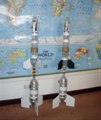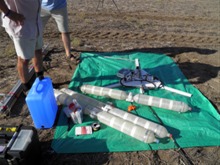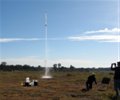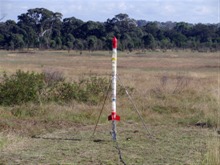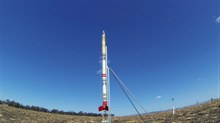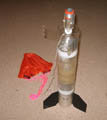|
|
| Rocket Gallery |
 |
This section contains the
technical specifications of water rockets built by the Air
Command team.
They are arranged roughly in order of
development.
Rocket variations refer to a
typical rebuild of the same rocket. A rebuild is
generally due to either damage to the rocket after a
hard landing or an added feature.
Rocket Naming
The first few rockets did not have
names, and were later designated AC #1.. AC#5. Then
we used kids nicknames, and a few others. With
Acceleron we began using sub-atomic particle names
for the rockets. We try to choose the subatomic
particle that reflects something unique about the
rocket. Acceleron - is used to accelerate upper
stages, Graviton performed our zero g-experiments,
Gluon was our first use of glue in rocket
construction, Neutrino is a small rocket, the Photon
rockets are fast. etc.
Click the image below to view a comparison of
the rocket sizes,
or scroll down the page for full details and photos.

|
|
|
| AC #1 |
 |
AC #1 |
|
|
|
|
|
|
|
|
Variations: |
None |
|
Entered
Service: |
4th June 2006 |
|
Capacity: |
1.25 L |
|
Nozzle Size: |
9 mm |
|
Fill Volume: |
390 mL |
|
Dimensions: |
Length:
300 mm, diameter: 90 mm |
|
Launch Pressure: |
~ 40 - 50 psi |
| Dry
Weight: |
51 grams |
|
Recovery: |
None |
|
Current Status: |
Retired |
|
Notes: |
First bottle launched on the
horizontal launcher. It had no fins
or nosecone. |
|
|
|
Back to top
| AC #2 |
 |
AC #2 (lower right) |
|
|
|
|
|
|
|
|
Variations: |
None |
|
Entered
Service: |
11th June 2006 |
|
Capacity: |
1.25 L |
|
Nozzle Size: |
9 mm |
| Dry
Weight: |
Unknown - ~ 110
grams |
|
Fill Volume: |
430 mL |
|
Launch Pressure: |
~ 30 - 70 psi |
|
Recovery: |
None |
|
Current Status: |
Retired |
|
Notes: |
First bottle launched on the
vertical launcher. Simple nosecone
made from another bottle. The ring
fin used Venetian blinds for struts.
These buckled badly on landing. |
|
|
|
Back to top
| AC #3 |
 |
AC #3 (on launcher) |
|
|
|
|
|
|
|
|
Variations: |
None |
|
Entered
Service: |
11th June 2006 |
|
Capacity: |
2 L |
|
Nozzle Size: |
9 mm |
|
Fill Volume: |
620 mL |
|
Launch Pressure: |
~ 30 - 70 psi |
| Dry
Weight: |
Unknown - ~120
grams |
|
Recovery: |
None |
|
Current Status: |
Retired |
|
Notes: |
First 2L rocket launched on the
vertical launcher. The fins were
similar to AC #2. Also became
quite damaged on impact. |
|
|
|
Back to top
| AC #4 |
|
|
|
Variations: |
I and II ( Later became
Brotanek
) |
|
Entered
Service: |
18th June 2006 ( I )
2nd July 2006 ( II ) |
|
Capacity: |
1.25L |
|
Nozzle Size: |
9mm |
|
Fill Volume: |
450 mL |
|
Dimensions: |
Length:
Unknown, diameter: 90 mm |
|
Launch Pressure: |
Unknown, but around 80psi |
| Dry
Weight: |
Unknown |
|
Recovery: |
None. ( I )
Deploying air brakes. ( II ) |
|
Current Status: |
Retired |
|
Notes: |
This rocket had more solid fin
struts ( IC packaging ) and a shaped
medium density large nosecone.
Version II later included three
air brakes that deployed using a
wire ring that would fall off. This
worked partially only on one
occasion and the design was
abandoned. The ring had two sinkers
attached on wires that would help
work the ring loose as they flapped
about. |
|
|
|
Back to top
| AC #5 |
 |
AC #5 ( middle ) |
|
|
|
|
|
|
|
|
Variations: |
None |
|
Entered
Service: |
18th June 2006 |
|
Capacity: |
2 L |
|
Nozzle Size: |
9mm |
|
Fill Volume: |
620 mL |
|
Dimensions: |
Length:
Unknown, diameter: 110 mm |
|
Launch Pressure: |
Unknown, but around 80psi |
| Dry
Weight: |
Unknown |
|
Recovery: |
None. |
|
Current Status: |
Retired |
|
Notes: |
This rocket had 2 fin struts
made out of PVC moulding. |
|
|
|
Back to top
Back to top
| AC #6 |
 |
AC #6 |
|
|
|
|
|
|
|
|
Variations: |
None |
|
Entered
Service: |
18th June 2006 |
|
Capacity: |
2 L |
|
Nozzle Size: |
9mm |
|
Fill Volume: |
620 mL |
|
Dimensions: |
Length:
Unknown, diameter: 110 mm |
|
Launch Pressure: |
Unknown, but around 80psi |
| Dry
Weight: |
Unknown |
|
Recovery: |
None. |
|
Current Status: |
Retired |
|
Notes: |
This rocket had 2 fin struts
made out of PVC moulding. The fins
were taken from AC#5 The nose cone
contained a heavy foam back half of
a kids ball. The nosecone also had
an outside shell made from the top
of a bottle. The body was made from
a Coke bottle. |
|
|
|
Back to top
Back to top
Back to top
| Cena |
 |
Cena
( second from the right ) |
 |
Cena |
|
|
|
|
|
Variations: |
None |
|
Entered
Service: |
9th July 2006 |
|
Capacity: |
1.25 L |
|
Nozzle Size: |
9mm |
|
Fill Volume: |
450mL |
|
Dimensions: |
Length:
525 mm, diameter: 90 mm |
|
Launch Pressure: |
120 psi |
| Dry
Weight: |
Unknown |
|
Recovery: |
None. |
|
Current Status: |
Retired |
|
Notes: |
This was a good performing early
rocket. It made quite a number of
flights with little damage done to
it. It was painted gold to make it
easier to see. |
|
|
|
Back to top
| John John |
 |
John John
( left most) |
|
|
|
|
|
|
|
|
Variations: |
None |
|
Entered
Service: |
30th July 2006 |
|
Capacity: |
600 mL |
|
Nozzle Size: |
9mm |
|
Fill Volume: |
230 mL |
|
Dimensions: |
Length:
410 mm, diameter: 75 mm |
|
Launch Pressure: |
80 - 120 (max to date) |
| Dry
Weight: |
70 grams |
|
Recovery: |
None. |
|
Current Status: |
Retired |
|
Notes: |
This rocket has a nosecone made
from medium density foam, and fin
struts are made from bamboo
reinforced Venetian blinds. This
rocket is pretty tough and survives
most landings simply because it is
so light. |
|
|
|
Back to top
| TNT |
 |
TNT
( third from the right) |
 |
TNT |
 |
TNT
( fourth from the right ) |
|
|
Variations: |
None |
|
Entered
Service: |
30th July 2006 |
|
Capacity: |
1.25 L |
|
Nozzle Size: |
9mm |
|
Fill Volume: |
450 mL |
|
Dimensions: |
Length: 520 mm, diameter: 90 mm |
|
Launch Pressure: |
110 psi typical,
130 psi (max) |
| Dry
Weight: |
Unknown |
|
Recovery: |
Parachute using the
NOAA
technique. |
|
Current Status: |
Retired |
|
Notes: |
This was one of our
first rockets to use a parachute
successfully. Later it was painted
black to make it easier to see in
the sky. |
|
|
|
Back to top
| Jordan |
 |
Jordan
( fourth from the left ) |
 |
Jordan
( third from the right ) |
 |
Jordan |
 |
Jordan |
|
|
Variations: |
None |
|
Entered
Service: |
30th July 2006 |
|
Capacity: |
1.25 L |
|
Nozzle Size: |
9mm |
|
Fill Volume: |
370 mL |
|
Dimensions: |
Length: 460 mm, diameter: 90 mm |
|
Launch Pressure: |
100 psi typical 120
psi (max) |
| Dry
Weight: |
93 grams |
|
Recovery: |
None. |
|
Current Status: |
Retired |
|
Notes: |
Our lightest and
highest flying rocket at the time.
It was specifically designed to be
lean and lightweight. There was a
small brass weight under the medium
density foam nosecone.
The first rocket we flew with air
only. |
|
|
|
Back to top
| X-21 |
 |
X-21 |
|
|
|
|
|
|
|
|
Variations: |
None |
|
Entered
Service: |
5th August 2006 |
|
Capacity: |
2.5 L ( 2 x 1.25L )
Used 6mm Robinson coupling |
|
Nozzle Size: |
9mm |
|
Fill Volume: |
Unknown |
|
Dimensions: |
Length: Unknown, diameter: 90 mm |
|
Launch Pressure: |
100 psi |
| Dry
Weight: |
Unknown |
|
Recovery: |
Parachute using the
NOAA
technique. |
|
Current Status: |
Retired |
|
Notes: |
This was our first
rocket to use multiple bottles. It
suffered from stability issues, and
the parachute did not deploy quite
well. This rocket later turned into
"OO" |
|
|
|
Back to top
| Spek |
 |
Spek I |
 |
Spek II |
 |
Spek II |
 |
Spek II |
 |
Spek III |
 |
Spek III
( third from the right ) |
 |
Spek III |
|
|
Variations: |
I, II and III |
|
Entered
Service: |
5th August 2006 ( I
)
13th August 2006 ( II )
20th August 2006 ( III ) |
|
Capacity: |
1.25 L |
|
Nozzle Size: |
9mm |
|
Fill Volume: |
600 - 700 mL |
|
Dimensions: |
Length: Unknown mm, diameter:
110 mm |
|
Launch Pressure: |
110 psi ( I )
80 psi ( II )
120 psi ( III ) |
| Dry
Weight: |
162 grams without
nosecone and camera. (camera = 40
grams) |
|
Recovery: |
Parachute using the
NOAA
technique. |
|
Current Status: |
Retired |
|
Notes: |
Spek I started out
as a single bottle rocket. Spek II
was our first rocket equipped with a
video camera. The Spek rocket was
extended by the camera payload
section. The camera was well padded
inside the payload section. Both
Spek I and II used only 2 PVC
moulding struts for the ring fin.
Spek III had an upgraded fin
structure, using 3 IC packaging
struts. This rocket later evolved
into the
Frankovka series. The nosecone
was also upgraded. |
|
|
|
Back to top
| D.Y. |
 |
D.Y.
( third from the left ) |
 |
D.Y. |
 |
D.Y. |
|
|
Variations: |
None |
|
Entered
Service: |
2nd October 2006 |
|
Capacity: |
2.25 L |
|
Nozzle Size: |
9 mm |
|
Fill Volume: |
668 ml |
|
Dimensions: |
Length: 640 mm, diameter:
110 mm |
|
Launch Pressure: |
130 psi |
| Dry
Weight: |
188 grams |
|
Recovery: |
Parachute using the
NOAA
technique. |
|
Current Status: |
Retired |
|
Notes: |
This was an
experimental 2.25L rocket. It was
designed to test two new
technologies. The first was the use
of plastic strapping bands for
bottle reinforcement and the second
was an inexpensive and lightweight
ring fin design. The fins were
attached by bamboo skewers and tape
only. |
|
|
|
Back to top
Back to top
| OO |
 |
OO ( I )
( fourth from the left ) |
 |
OO ( I ) |
 |
OO ( II ) |
 |
OO ( II ) |
 |
OO ( II ) |
 |
OO ( II ) |
|
|
Variations: |
I and II |
|
Entered
Service: |
13th August 2006 ( I )
20th August 2006
( II ) |
|
Capacity: |
2.5 L ( 2 x 1.25L ) - 6mm Robinson
coupling |
|
Nozzle Size: |
9mm |
|
Fill Volume: |
750 ml |
|
Dimensions: |
Length: mm, diameter: 90 mm |
|
Launch Pressure: |
80 psi ( I )
140 psi (typical) 150 psi (max
to date) ( II ) |
| Dry
Weight: |
|
|
Recovery: |
Version I and II used a single
chute NOAA.
A number of flights were flown with
twin chutes. |
|
Current Status: |
Retired |
|
Notes: |
This rocket used to hold Air
Command's flight duration record of
31.5 seconds. This is a very
successful rocket for us. It has
performed very well over a great
number of flights.
Version I was the first rocket that
used flat fins as opposed to the
normal ring fin. The rocket was
quite unstable, but may have been
due to a faulty nozzle.
Version II had the fins lowered on a
ring fin. This rocket also holds the
highest pressure rocket launched by
us at 150 psi. |
|
|
|
Back to top
| Frankovka |
 |
Frankovka I |
 |
Frankovka II |
 |
Frankovka III |
 |
Frankovka III |
|
|
Variations: |
I , II and III |
|
Entered
Service: |
8th October 2006 ( I )
22nd October 2006
( II )
11th November 2006
( III ) |
|
Capacity: |
4 L ( 2 x 2L ) - 6mm Robinson
coupling ( I ) and ( III )
4.25 L ( 1 x 2L and 1x 2.25L) - 6mm Robinson
coupling ( II ) |
|
Nozzle Size: |
9 mm (typical) - 7 mm experiments |
|
Fill Volume: |
1250 ml |
|
Dimensions: |
Length:
995 mm, diameter: 110 mm |
|
Launch Pressure: |
130 psi (typical) 140 psi (max
to date) |
| Dry
Weight: |
415 grams ( II )
472 grams ( III ) - includes camera
and flight computer. |
|
Recovery: |
Version I and II used a single
chute NOAA.
Version III uses side
deploying parachute deployed by
V1.2
of the flight computer. |
|
Current Status: |
Retired |
|
Notes: |
This rocket carried a small
video camera. After the last crash,
the flight computer was removed, as
well as the fin section and used in
the Polaron rocket. |
|
|
|
Back to top
| J4Y (J4) |
|
|
|
Variations: |
I, II, III, IIIb,
IV |
|
Entered
Service: |
30th November 2006
( I )
11th January 2007 ( II )
16th September 2007 ( III )
(exploded on launch pad)
30th September 2007 ( IIIb )
18th November 2007 ( IV ) |
|
Capacity: |
3.75 L ( 3 x 1.25L ) - two
8mm Robinson
couplings ( I )
5 L ( 4 x 1.25L) - three 8mm
Robinson couplings ( II )
5 L ( 4 x 1.25L) - three 8mm
Robinson couplings ( III & IIIb )
5 L ( 4 x 1.25L) - three 8mm
Robinson couplings ( IV ) |
|
Nozzle Size: |
7 mm or 9 mm |
|
Dimensions: |
Length: 1260 mm, diameter: 90 mm
Length: 1340 mm, diameter: 90 mm
( III )
Length: 1520 mm, diameter: 90
mm ( IV ) |
|
Fill Volume: |
1000 - 1100 ml ( I )
1250 ml ( II, III, IV ) |
|
Launch Pressure: |
130 psi (typical) 135 (max to
date) ( I ) |
| Dry
Weight: |
391 grams ( I )
522 grams ( II )
556 grams ( III ) with camera.
496 grams ( IIIb ) with altimeter,
no camera
537 grams ( IV ) with altimeter, no
camera, shock absorbing nose cone |
|
Recovery: |
Parachute using the
NOAA
technique. ( I & II )
Single parachute
V1.3.2 flight computer. ( III, IIIb,
IV ) |
|
Current Status: |
Retired |
|
Notes: |
Our first rocket
to use 3 bottles coupled together.
The rocket has 3 conventional fins
attached to a ring supported by
struts. The fins are behind the
nozzle. Later renamed to just J4.
J4 II had an extra bottle added and
a new nosecone.
J4 III has a new set of fins and a
new deployment system. Exploded on
the launch pad during filling for
first flight.
J4 IIIb has been completely rebuilt
with new aluminium couplings. First
of our rockets to fly an altimeter.
J4 IV is a rebuild of J4 IIIb after
the parachute failed to open and
crashed heavily. Being used for foam
vs water research. |
|
|
|
Back to top
| Polaron |
 |
Polaron |
 |
Polaron |
 |
Polaron II |
 |
Polaron III |
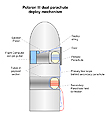 |
A diagram of Polaron III's twin parachute
deployment mechanism. |
 |
Polaron IV |
 |
Polaron IV |
 |
Polaron IV |
 |
Polaron IVb with Gluon
boosters |
 |
Polaron IVd with Gluon
boosters |
 |
Polaron V
with Gluon
II boosters |
 |
Polaron V
with Gluon
II boosters |
 |
Polaron VI with Gluon
II boosters
(right) |
 |
Polaron VI with Gluon
II boosters |
 |
Polaron VIb with Gluon
II boosters |
 |
Polaron VII |
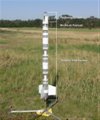 |
Polaron VIIIx |
 |
Polaron G1 |
 |
Polaron G2 |
 |
Polaron G2b |
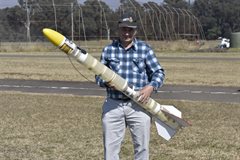 |
Polaron G3 |
|
|
Variations: |
I, II, III, IV, IVb
IVd, V, VI, VIb, VII, VIIIx, G1, G2,
G2b, G3 |
|
Entered
Service: |
11th January 2007 (
I )
3rd February 2007 ( II )
18th February 2007 ( III )
26th January 2008 ( IV )
21st February 2008 (IVd dummy)
23rd February 2008 ( IVb )
3rd May 2008 ( V )
31st May 2008 ( VI )
28th February 2009 ( VIb )
13th December 2009 ( VII )
10th January 2010 ( VIIIx )
13th June 2010 ( G1 )
29th January 2011 ( G2 )
10th April 2011 ( G2b )
26th August 2017 ( G3 ) |
|
Capacity: |
8 L ( I )
6 L ( II )
8 L ( III, IV and IVb)
2 L ( IVd )
10L ( V )
12.8L ( VI )
12.8L ( VI b)
12.5L ( VII )
9.8L ( VIIIx )
12.4L ( G1 )
21.4L ( G2 )
16L ( G2b )
10.9L ( G3 ) |
|
Nozzle Size: |
9 mm ( I, II, III,
IV
and V )
8.9 mm ( IVb, IVd, VI )
9.45mm ( VIb )
15mm ( VII )
15mm ( VIIIx )
16mm ( G1, G2, G2b, G3 ) |
|
Dimensions: |
Length: 1730 mm, diameter:
110 mm ( I )
Length 1520 mm, diameter 110 mm (
III )
Length: 1420 mm, diameter:
110 mm ( IV & IVb )
Length: 1520 mm, diameter: 110 mm (
IVd )
Length: 1750 mm, diameter: 110 mm (
V )
Length: 1930 mm, diameter: 110 mm (
VI )
Length:
2060 mm, diameter: 110 mm (
VIb )
Length:
2150 mm, diameter: 110 mm ( VII )
Length:
1750 mm, diameter: 110 mm ( VIIIx )
Length:
2070 mm, diameter: 110 mm ( G1 )
Length: 3010 mm, diameter: 110 mm ( G2 )
Length: 2420 mm, diameter: 110 mm ( G2b )
Length: 1690 mm, diameter: 110 mm ( G3 ) |
|
Fill Volume: |
1900 mL ( I )
1250 mL ( II )
1900 mL ( III )
2000 mL ( IV and IVb )
1500 mL ( IVd )
2000 mL ( V )
2400 mL ( VI and VIb )
2900 mL ( VII )
2600 mL ( VIIIx )
3000 mL ( G1 )
4000 mL ( G2 )
3800 mL ( G2b )
2800 mL ( G3 ) |
|
Launch Pressure: |
90 psi ( II ) to
date due to leak
130 psi ( III ) max to date
125 psi ( IV ) max to date
110 psi ( IVb ) max to date
100 psi ( IVd )
120 psi ( V )
130 psi ( VI )
120 psi ( VIb )
130 psi ( VII )
110 psi ( VIIIx )
230 psi ( G1 )
~230 psi ( G2 )
240 psi ( G2b )
210 psi ( G3 ) |
| Dry
Weight: |
660 grams ( I )
550 grams ( II ) without camera.
689 grams ( III ) with camera. ( 640
g without camera )
880 grams ( IV ) with camera,
altimeter and flight computer.
928 grams ( IVb ) with camera,
altimeter and flight computer.
~ 850 grams ( IVd )
1072 grams ( V ) with camera,
altimeter, parachute and flight computer.
1087 grams ( VI ) with camera,
altimeter, parachute and flight
computer.
1200 grams ( VIb ) with camera,
altimeter, parachute and flight
computer.
1230 grams ( VII ) with camera,
altimeter, parachute and flight
computer.
1080 grams ( VIIIx ) with camera,
altimeter, parachute and flight
computer. MicroLab mercury switch
experiment.
1580 grams ( G1 ) with camera,
altimeter, parachute, flight
computer, Craig's flight computer.
2200 grams ( G2 ) with camera,
altimeter, parachute, flight
computer, Craig's flight computer.
1815 grams ( G2b ) with camera,
altimeter, 2x parachute, flight
computer, MAD backup deploy
1340 grams ( G3 ) with camera,
altimeter, parachute, flight
computer |
|
Recovery: |
Uses side deploying
parachute deployed by
V1.2
of the flight computer. ( I and II )
Polaron III uses the same as above
but a second parachute is pulled out
by the first, out of a second
storage compartment.
Polaron IV, IVb, V and VI uses a single 1.15m
diameter
parachute. Deployed by version
1.3.2 of the flight computer.
Polaron IVd used NOAA.
Polaron VIb, VII, VIIIx, G1 used version 1.6 of the
FC
Polaron G2 uses new in-line
deployment mechanism with fiberglass
nosecone.
Polaron G2b uses side deploy
controlled by V1.6 FC, with back up
parachute controlled by ST II with
MAD |
|
Current Status: |
Active |
|
Notes: |
( I ) Flight computer and
fin section taken from
Frankovka.
This rocket never flew as it had
a major malfunction on the launch
pad. One of the bottles severely
distorted and the coupling leaked.
This rocket is equipped with a small
digital video camera.
Polaron II had one bottle removed,
and new fins fitted.
Polaron III was completely rebuilt
after Polaron II crashed. All new
bottles, new couplings, new payload
section with a second chute. New
plastic fins attached by large
rubber bands.Polaron IV is newly
rebuilt. Special features include:
Top bottle is inverted to allow
filling from top.
Reinforced bottle bottoms with
another bottle.
FlyCamOne V2 video camera
Z-log altimeter.
Polaron IVb is identical to version
IV except for new removable fin set
to support the boosters and has
launch lugs for the guide rail.
Polaron IVd was a dummy rocket
designed to test the booster system
in place of the actual rocket.
Polaron V has had an extra 2L bottle
added. Designed to fly with
Gluon II boosters
Polaron VI has a new body
constructed from 3 spliced pairs and
using two 22mm tornado couplings.
Those are Robinson coupled to the
lowest 2L bottle from Polaron V in
order to generated foam using Jet
Foaming.
Polaron VIb is a complete rebuild of
Polaron VI, with a larger fin set,
slightly larger nozzle and a new
nosecone.
Polaron VII was used to test
re-enforced spliced pairs in flight.
Polaron VIIIx was used to fly the
first MicroLab experiment. It was
built from the remaining bottles
used on Acceleron V.
Polaron G1 was reinforced with two
layers of 200gsm fiberglass.
Polaron G2 was our first large scale
- high pressure rocket.
Polaron G2b CATOed at 250psi on
first attempt. |
|
|
|
Back to top
| Acceleron |
 |
Acceleron II |
 |
Acceleron II |
 |
Acceleron III
with Tachyon sustainer. |
 |
Acceleron IIIb |
 |
Acceleron IIIb
with Tachyon II |
 |
Acceleron IIIb
with Tachyon II |
 |
Acceleron IIIb
with Tachyon II |
 |
Acceleron IIIb
with Tachyon II |
 |
Acceleron IV
with Tachyon III |
 |
Acceleron V
with Axion IV |
 |
Acceleron V
with Axion IV |
 |
Acceleron Vb
with Axion IVb |
 |
Acceleron Vc
with Axion IVb |
|
|
Variations: |
I, II, III, IIIb, IV,
V, Vb
and Vc |
|
Entered
Service: |
11th January 2007 (
I )
31st March 2007 ( II )
5th July 2007 [Exploded during test] ( III )
29th July 2007 ( IIIb )
29th March 2008 ( IV )
4th July 2009 ( V )
25th July 2009 ( Vb )
27th March 2010 ( Vc ) |
|
Capacity: |
12.75 L ( I )
18.75 L ( II )
24.75 L ( III )
24 L ( IIIb )
18 L ( IV )
30 L ( V and Vb )
28 L ( Vc ) |
|
Nozzle Size: |
3 x 8.8 mm ( I )
3 x 10 mm ( II )
3 x 10 mm ( III )
3 x 10 mm ( IIIb )
3 x 10 mm ( IV )
3 x 13.5 mm ( V )
3 x 15.6 mm ( Vb and Vc ) |
|
Dimensions: |
Length: 1310 mm, diameter:
3 segments each 110 mm ( I )
Length: 1570 mm, diameter: 3
segments each 110 mm ( II )
Length: 1590 mm, diameter: 3
segments each 110 mm ( III and IIIb )
Length: 1770 mm, diameter: 3
segments each 90 mm ( IV )
Length: 1530 mm. diameter: 3 segments
each 110 mm ( V and Vb )
Length: 1420 mm. diameter: 3
segments each 110 mm ( Vc ) |
|
Fill Volume: |
3.75 L - 1.25 per
segment ( I )
5.25 L - 1.75 L per segment ( II )
5.25L ( III and IIIb )
4.5 L - 1.5L per segment ( IV )
9.6 L - 3.2L per segment ( V )
7.5 L - 2.5L per segment ( Vb and Vc ) |
|
Launch Pressure: |
120 psi.
( I )
120 psi max to date. ( II )
120 psi ( III )
110 psi ( IIIb )
130 psi ( IV )
130 psi ( V & Vb )
120 psi ( Vc ) |
| Dry
Weight: |
950 grams plus
about 600ml of ballast in the dummy
payload section. ( I )
1476 grams plus
about 600ml of ballast in the dummy
payload section. ( II )
Unknown
but ~2000grams ( III )
1980 grams. Includes parachute ( IIIb )
2046 grams. Includes parachute ( IV
)
2.9 kg. Including twin
parachutes ( V & Vb )
2.88 kg Including twin parachutes (
Vc ) |
|
Recovery: |
900mm diameter
parachute deployed using the
NOAA
technique. ( I )
Twin chutes - one 900mm diameter
parachute deployed using the
NOAA
technique and pulls out a secondary
420 mm
parachute ( II )
Single 1500 mm parachute deployed
using FC 1.4.( III, IIIb an IV )
Version V, Vb and Vc use dual redundant systems using V1.6
flight computers with twin
parachutes. Primary: 1500mm,
Secondary: 1150mm. |
|
Current Status: |
Active |
|
Notes: |
This is our first
cluster rocket being used to develop
a booster for a two stage rocket.
It carries a dummy payload section
with about 600ml of water for
ballast. The water empties before the
rocket lands.
Recently it has been fitted with new
fins. ( I )
Acceleron II has had a 2L bottle
added to each segment, all the
bottle bases have been reinforced
with strapping tape and a new longer
central tube has been added. ( II )
Acceleron III exploded during a
static test. ( III )Acceleron
IIIb is the rebuild of Acceleron III
with additional reinforcements.
Helped set our new personal highest
altitude.
Acceleron IV is a rebuild to use the
stronger 1.25L bottles instead of
the 2L bottles.
Acceleron V is a different design
using a ring brace and staging
mechanism near the bottom. The
booster segments act as guide rails
for the long sustainer. Acceleron
Vb is an improved version of V with
larger nozzles. Acceleron Vc uses
new reinforced spliced bottles. It
helped propel Axion IVb to 810' for
the first time. |
|
|
|
Back to top
| Tachyon |
|
|
|
Variations: |
I, II, III, IV, IVb, V, VII,
VIII |
|
Entered
Service: |
23rd June 2007
( I )
29th July 2007 ( II )
29th March 2008 ( III )
28th June 2008 ( IV )
2nd August 2008 ( IVb )
2nd August 2008 ( V )
10th January 2010 ( VII )
1st August 2010 ( VIII ) |
|
Capacity: |
2.5 L ( 2 x 1.25L ) -
one 8mm Robinson coupling ( I, II, III, IV
and IVb)
3.35L ( V ) 2.1L spliced pair
Robinson coupled to 1.25L
3.35L ( VII ) 2.1L spliced pair
Tornado coupled to 1.25L
2L ( VIII ) 2x 1.25L spliced pair of
bottles. |
|
Nozzle Size: |
5 mm, 7 mm or 9 mm
( I,
II, III, IV and IVb )
9 mm ( V )
9mm ( VII )
9mm ( VIII ) |
|
Dimensions: |
Length: 770 mm,
diameter: 90 mm ( I,
II, III, IV and IVb )
Length: 1140mm, diameter: 90 mm ( V
)
Length:
920mm, diameter: 90mm ( VII )
Length:
670mm, diameter: 90mm ( VIII ) |
|
Fill Volume: |
800ml/1000ml as a
sustainer.( I,
II and III )
800ml when testing as a single
stage. ( I & II )
870ml ( IV, IVb )
1300ml ( V )
1000ml ( VII )
600ml ( VIII ) |
|
Launch Pressure: |
120 psi (typical) (
I )
130 psi (max to date when testing) (
I )
110 psi (typical) ( II )
130 psi (typical) ( III )
180 psi (typical) ( IV )
125 psi ( V )
130 psi ( VII )
110 psi ( VIII ) |
| Dry
Weight: |
337 grams ( I )
366 grams ( II )
(can be reduced by 30 grams by using
a lighter battery)
395 grams + 37grams camera ( III )
470 grams ( IV )
513 grams + 37grams camera ( V )
380 grams ( VII )
260 grams ( VIII ) |
|
Recovery: |
Single 420 mm
diameter parachute, deployed by
version 1.3.1 of the flight
computer. ( I & II ) V1.3.2 for
( III ) V1.5 for ( IV, IVb and V )
flight computer V1.6 ( VII, VIII ) |
|
Current Status: |
Active |
|
Notes: |
This rocket is
specifically designed as a sustainer
to operate with
Acceleron III.
Tachyon II has had the fin
structure upgraded to better support
the sustainer during lift-off.
Boosted by Acceleron IIIb held our
highest personal altitude record of
~ 192 meters.
Tachyon III is a rebuild after
Tachyon II was destroyed. Currently
has flown to 188 m (617' ) Flies
with FlyCamOne2
Tachyon IV used reinforced bottles,
and V1.5 of the flight computer but
blew up on the pad.
Tachyon IVb was a rebuild of IV and
fitted with new fins.
Tachyon V is has special carbon
fiber support tubes and a
streamlined lower bottle. It also
has 4 plywood fins.
Tachyon VII was used to first
test the in-line parachute
deployment mechanism.
Tachyon VIII was designed to test
the Mk3. Staging mechanism. |
|
|
|
Back to top
Back to top
| Graviton |
 |
Graviton |
 |
Graviton
( left ) |
 |
Graviton |
|
|
Variations: |
None |
|
Entered
Service: |
30th September 2007 |
|
Capacity: |
3.75 L ( 3 x 1.25L ) -
two 8mm Robinson couplings |
|
Nozzle Size: |
9 mm |
|
Dimensions: |
Length: 1510 mm,
diameter: 90 mm. |
|
Fill Volume: |
900 mL |
|
Launch Pressure: |
110psi
(typical) |
| Dry
Weight: |
554 grams with camera + M&M payload |
|
Recovery: |
Single 420 mm
diameter parachute, deployed by
V1.3.2
of the flight computer. |
|
Current Status: |
Retired |
|
Notes: |
This rocket is
based on the
Hyperon Standard Platform. The
rocket contains a large
unpressurised payload section for
doing zero-g experiments. |
|
|
|
Back to top
Back to top
| Axion |
|
|
|
Variations: |
I, II, IIb, IIc, III, IIIb, IIIc, IVb,
IVd, V, VI, VII, VIII, IX, X, G1, G2, G3,
G4, G5, G6 |
|
Entered
Service: |
31st may 2008 ( I )
21st December 2008 ( II )
15th March 2009 ( III )
4th July 2009 ( IV )
25th July 2009 ( IVb )
25th July 2009 ( V )
13th September 2009 ( IVd )
24th April 2010 ( G1 )
13th June 2010 ( VI )
28th August 2010 ( IIIb )
28th August 2010 ( IIb )
30th October 2010 ( VII )
27th March 2011 ( IIIc & VIII)
10th April 2011 ( IIc )
8th May 2011 ( G2 )
25th February 2012 ( G3 )
14th October 2012 ( IX & X )
9th June 2013 ( G4 )
5th October 2014 ( G5 )
26th November 2016 ( G6 ) |
|
Capacity: |
7.5 Liters ( I )
5.45 Liters ( II )
5.3 Liters ( IIb )
6.3 Liters ( IIc )
3.35 Liters ( III , IIIc )
4.2 Liters ( IIIb )
6.7 Liters ( IV, IVb, IVd and V )
6 Liters ( G1 )
8 Liters ( VI )
7.5 Liters ( VII )
2.1 Liters ( VIII )
8.3 Liters ( G2 )
5.3 Liters ( G3 )
9.6
Liters ( IX )
10.9
Liters ( X )
7.2 Liters ( G4 )
8.2 Liters ( G5 )
5.5 Liters ( G6 ) |
|
Nozzle Size: |
9 mm, 15mm
9 mm ( IIb, IIc, III, IIIb, IIIc, IV, IVb, IVd,
V, VI, VII, VIII, G2, G3, IX, X, G4,
G5, G6 )
9.5 mm (G1) |
|
Dimensions: |
Length: 1960 mm,
diameter: 90 mm. ( I )
Length: 1520 mm,
diameter: 90 mm. ( II )
Length: 1540 mm,
diameter: 90 mm. ( IIb )
Length: 1690 mm,
diameter: 90 mm. ( IIb )
Length: 960 mm,
diameter: 90 mm. ( III )
Length: 1110 mm,
diameter: 90 mm. ( IIIb )
Length: 1060 mm,
diameter: 90 mm. ( IIIc )
Length:
1750 mm, diameter: 90 mm. ( IV, IVb,
IVd
)
Length 1750 mm, diameter: 90
mm. ( V
)
Length 1620 mm, diameter: 90
mm. ( G1
)
Length 2050 mm, diameter: 90
mm. ( VI
)
Length 1960 mm, diameter: 90
mm. ( VII
)
Length 680 mm, diameter: 90
mm. ( VIII
)
Length 2040mm, diameter 90 mm ( G2 )
Length 1390mm, diameter 90 mm ( G3 )
Length 2400mm, diameter 90 mm ( IX )
Length 2750mm, diameter 90 mm ( X )
Length 1810mm, diameter 90 mm ( G4 )
Length 2160mm, diameter 90 mm ( G5 )
Length ??mm, diameter 90 mm ( G6 ) |
|
Fill Volume: |
1800 mL ( I and II
)
1200 mL ( IIb )
1800 mL ( IIc )
400 grams flour ( III )
1000 mL ( IIIb, IIIc )
1800 mL ( IV ) foam + water
1300 mL ( IVb ) foam + water
1400 mL ( IVd, V ) foam + water
1600 mL (G1) foam + water
1900 mL ( VI ) foam + water
1500 mL ( VII ) foam + water
700 mL ( VIII )
2100 mL ( G2 ) foam + water
1400 mL ( G3 )
2000 mL ( IX, X )
1700 mL ( G4 ) foam + water
2500 mL ( G5 ) foam + water
1500 mL ( G6 ) foam + water |
|
Launch Pressure: |
130 psi typical ( I
and II )
120 psi typical ( IIb, IIc, III, IIIb,
IIIc, VIII )
130 psi ( IV, IVb, IVd and V )
245 psi (G1)
120 psi ( VI , VII )
200 psi ( G2, G4, G5 )
190 psi ( G3 )
125 psi ( IX, X )
200 psi ( G6 ) |
| Dry
Weight: |
759 grams with camera, FC parachute
and altimeter. ( I )
562 grams, no camera and no
altimeter ( II )
548 grams (II - new version)
including camera, altimeter,
parachute, nozzle
585 grams ( IIb )
595 grams ( IIc )
370 grams, no camera and no
altimeter ( III )
430 grams, with MAD ( IIIb )
413 grams ( IIIc )
675 grams ( IV )
720 grams ( IVb )
760 grams ( V )
1030 grams (IVd) including camera
and ballast.
951 grams (G1)
890 grams ( VI )
805 grams ( VII ) including camera,
altimeter, parachute
227 grams ( VIII )
1132 grams ( G2 )
710 grams ( G3 )
805
grams ( IX )
920
grams ( X )
963 grams ( G4 )
1110 grams ( G4 ) including camera,
altimeter, parachute, booster ring.
1085 grams ( G5 )
?? grams ( G6 ) |
|
Recovery: |
Parachute recovery.
Parachute deployed by V 1.3.1 of the
FC. ( I )
Parachute recovery.
Parachute deployed by V 1.5 of the
FC. ( II, III, IV and IVb)
Parachute recovery.
Parachute deployed by V 1.6 of the
FC. ( V, IVd, VI, VII )
Parachute recovery. Parachute
deployed by V 1.6 of the FC. ( G1 )
Parachute recovery. Parachute
deployed by V 1.6 of the FC,
triggered by MAD. ( IIb, IIIb )
Parachute recovery deployed by uMAD
and Servo Timer II ( III )
Parachute recovery deployed by Servo
Timer II ( IIIc, VIII )
Parachute recovery deployed by Servo
Timer II ( IIc, G2, G3, IX, X, G4,
G5, G6 ) |
|
Current Status: |
Active |
|
Notes: |
Our first modular
rocket made from spliced pairs using
22mm Tornado couplings. The rocket
also uses a new parachute made from
lightweight rip-stop nylon.
Version II had a spliced pair
removed to reduce performance when
flying in a smaller area.
Version III was used to test fly
flour instead of water.Version IV
was used as the sustainer for
Acceleron V. Version IVb had an
upgraded flight computer and larger
fins. It
was used as the sustainer for
Acceleron Vb. On 27th March 2010 it
was slightly modified to use a
tornado coupling and jet foaming
insert instead of a Robinson
coupling. Version V used the
top section of IVb and the bottom
section and fin set from Tachyon V.
Version IVd used a long boom to
place a camera a distance from the
rocket in order get information
about water behaviour in the lowest
bottle.
Version G-1 is a fiberglass
reinforced version with spliced
pairs wrapped in two layers of
200gsm glass.
Version VI uses a jet foaming insert
in the lowest tornado coupling.
Version IIb and IIIb used a MAD to
detect apogee.
Version VII had smaller fins, remote
arming and spliced pair as the top
bottle. Fitted with 8mm jet foaming
nozzle. Reached 864' on 30/10/10
Version IIc, III, IIIc and VIII were used
for testing the servo timer II
prototypes.
Version G2 was used for the first
Jet foaming spacer test. |
|
|
|
Back to top
| Baryon |
|
|
|
Variations: |
I, II, III, IV, IVb and
V |
|
Entered
Service: |
13th July 2008 ( I
)
2nd August 2008 ( II )
30th August 2008 ( III )
1st August 2010 ( IV )
29th August 2010 ( V )
22nd January 2011 ( IVb ) |
|
Capacity: |
2.1 Liters ( I )
7.2 Liters ( II )
9.2 Liters ( III )
3.1 Liters ( IV )
6 Liters ( V )
3.2 Liters ( IVb ) |
|
Nozzle Size: |
9 mm ( I,
III, IV, IVb and V )
15mm ( II, V ) |
|
Dimensions: |
Length: 590 mm,
diameter: 90 mm. ( I )
Length: 1110 mm, diameter: 110 mm. ( II )
Length: 1370 mm, diameter: 110 mm (
III )
Length:
560 mm, diameter: 110 mm (
IV )
Length:
1020 mm, diameter: 110 mm (
V )
Length:
740 mm, diameter: 110 mm ( IVb ) |
|
Fill Volume: |
800 mL ( I )
2800 mL ( II )
2400 mL ( III )
1000 mL ( IV and IVb)
2000 mL ( V ) |
|
Launch Pressure: |
110 psi typical ( I
)
120 psi ( II, V )
125 psi ( III )
110 psi ( IV )
100 psi ( IVb ) |
| Dry
Weight: |
293 grams ( I )
657 grams ( II )
959 grams ( III )
280 grams ( IV )
530 grams ( V )
627 grams ( IVb ) |
|
Recovery: |
Parachute recovery.
Parachute deployed by staging. The
sustainer pulls out a wire to
release the parachute. |
|
Current Status: |
Active |
|
Notes: |
The version I booster was
specifically built to test the Mk2
Katz Stager.
Version II was built to test the
Mk2 staging mechanism on a larger
booster.
Version III was fitted with drop
away boosters.
Version IV and V were designed to test the
Mk3 staging mechanism.
Version IVb was used for testing the
G2 parachute deployment mechanism |
|
|
|
Back to top
| Neutrino |
 |
Neutrino
(top) |
|
|
|
|
|
|
|
|
|
|
|
|
|
|
|
|
|
Variations: |
None |
|
Entered
Service: |
13th July 2008 |
|
Capacity: |
600mL |
|
Nozzle Size: |
9 mm |
|
Dimensions: |
Length: 430 mm,
diameter: 70 mm. |
|
Fill Volume: |
200 mL |
|
Launch Pressure: |
110 psi typical |
| Dry
Weight: |
130 grams |
|
Recovery: |
Ballistic recovery. |
|
Current Status: |
Active |
|
Notes: |
This sustainer was
specifically designed to test the
Mk2. Katz Stager.
Has been flown with 200grams of
flour instead of water. |
|
|
|
Back to top
| Photon |
 |
Photon |
 |
Photon II |
|
|
|
|
|
|
|
|
|
|
|
|
|
|
Variations: |
I and II |
|
Entered
Service: |
21st December 2008
( I )
28th February 2009 ( II ) |
|
Capacity: |
1000 mL ( I and II
) |
|
Nozzle Size: |
15 mm |
|
Dimensions: |
Length: 1920 mm,
diameter: 30 mm. |
|
Fill Volume: |
350 mL ( I )
340 mL ( II ) |
|
Launch Pressure: |
180 psi typical |
| Dry
Weight: |
320 grams ( I )
300 grams ( II ) |
|
Recovery: |
Split nosecone
recovery, deployed by V 1.5 FC. ( I
)
Split nosecone
recovery, deployed by V 1.6 FC. ( II
) |
|
Current Status: |
Active |
|
Notes: |
This was our first
T-8 FTC rocket.
Photon II had a new smaller and
lighter fin set and a new flight
computer fitted (V1.6) |
|
|
|
Back to top
| Pod 1 |
 |
Pod 1 |
|
|
|
|
|
|
|
|
|
|
|
|
|
|
|
|
|
Variations: |
None |
|
Entered
Service: |
25th April 2009 |
|
Capacity: |
4 L |
|
Nozzle Size: |
9 mm |
|
Dimensions: |
Length:
1070 mm,
diameter:
110 mm. |
|
Fill Volume: |
1.25L |
|
Launch Pressure: |
95 psi typical |
| Dry
Weight: |
570 grams |
|
Recovery: |
Parachute recovery.
Parachute deployed by V 1.3.3 of the
FC. |
|
Current Status: |
Retired |
|
Notes: |
This was Paul's
rocket design. It is built from 6
other older rocket components that
were no longer in use.
It's payload consists of Lego
astronauts and an R2 unit. |
|
|
|
Back to top
| Shadow |
 |
Shadow |
 |
Shadow II |
|
|
|
|
|
|
|
|
|
|
|
|
|
|
Variations: |
I and II |
|
Entered
Service: |
12th February 2012
( I )
30th June 2012 ( II ) |
|
Capacity: |
5.8 L ( I )
6.36L ( II ) |
|
Nozzle Size: |
19 mm ( I and II ) |
|
Dimensions: |
Length:
2580 mm,
diameter:
62 mm.
Length 2860 mm, diameter 62 mm. |
|
Fill Volume: |
1.3L water ( I )
1.7L water ( II ) |
|
Launch Pressure: |
300-500 psi 360psi
max to date ( I )
420psi ( II ) |
| Dry
Weight: |
1370 grams ( I )
1440 grams ( II ) |
|
Recovery: |
Parachute recovery.
Parachute deployed by Servo Timer
II. and uMAD. ( I )
Parachute recovery.
Parachute deployed by Servo Timer
II ( II ) |
|
Current Status: |
Active |
|
Notes: |
Our first all
fiberglass high pressure rocket.
Shadow II is a rebuild of Shadow
after it crashed |
|
|
|
Back to top
| Inverter |
 |
Inverter |
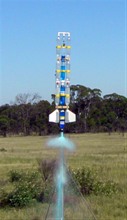 |
Inverter |
|
|
|
|
|
|
|
|
|
|
|
|
|
|
Variations: |
None |
|
Entered
Service: |
26th January 2013 |
|
Capacity: |
23.4 L |
|
Nozzle Size: |
16 mm |
|
Dimensions: |
Length:
1920 mm,
diameter:
3 x 90 mm (flat). |
|
Fill Volume: |
6.5L water |
|
Launch Pressure: |
120psi |
| Dry
Weight: |
1792 grams |
|
Recovery: |
Parachute recovery.
Parachute deployed by Servo Timer II |
|
Current Status: |
Active |
|
Notes: |
Rocket uses two
side air and one central water
pressure chamber joined by an air
manifold at the top. |
|
|
|
Back to top
| PETOne |
 |
PETOne |
|
|
|
|
|
|
|
|
|
|
|
|
|
|
|
|
|
Variations: |
None |
|
Entered
Service: |
17th March 2013 |
|
Capacity: |
1.25 L |
|
Nozzle Size: |
22 mm |
|
Dimensions: |
Length: 390 mm,
diameter: 90 mm |
|
Fill Volume: |
400mL water |
|
Launch Pressure: |
120psi |
| Dry
Weight: |
151 grams |
|
Recovery: |
Lawndart |
|
Current Status: |
Active |
|
Notes: |
Rocket is made only
out of PET plastic and nothing else.
Entry into the Materials challenge.. |
|
|
|
Back to top
| Dark Shadow |
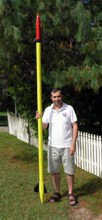 |
Dark Shadow #1 |
 |
Dark Shadow #2
(left) |
|
|
|
|
|
|
|
|
|
|
|
|
|
|
Variations: |
#1 and #2 |
|
Entered
Service: |
13th March 2015
( #1 )
12th September 2015 ( #2 ) |
|
Capacity: |
6.77 L (#1)
7.06 L (#2) |
|
Nozzle Size: |
15.5 mm (#1 and #2) |
|
Dimensions: |
Length: 2850 mm,
diameter: 63 mm ( #1 )
Length: 2960 mm,
diameter: 63 mm ( #2 ) |
|
Fill Volume: |
1800mL water |
|
Launch Pressure: |
640psi ( #1 )
740psi ( #2 ) |
| Dry
Weight: |
1550 grams (#1 including everything)
1620 grams (#2 including everything) |
|
Recovery: |
STII and 36"
Aerocon parachute |
|
Current Status: |
Active |
|
Notes: |
Our first carbon
fiber reinforced rocket. Caries Mod
6 logging altimeter, AltimeterOne
and HD camera #16 V3 |
|
|
|
Back to top
| L1ght Shadow |
|
L1ght Shadow |
 |
|
|
|
|
|
|
|
|
|
|
|
|
|
|
Variations: |
None |
|
Entered
Service: |
10th September 2016 |
|
Capacity: |
8.2 L |
|
Nozzle Size: |
15.5 mm / 38mm MMT |
|
Dimensions: |
Length: 2260 mm,
diameter: 80 mm |
|
Fill Volume: |
2800mL water |
|
Launch Pressure: |
260 psi |
| Dry
Weight: |
1880 grams |
|
Recovery: |
Parachute deployed
by StratoLogger CF triggering
ServoTimer II |
|
Current Status: |
Active |
|
Notes: |
Rocket is made from
fiberglass with an interchangeable
nozzle and can fly on 38mm pyro
motors. |
|
|
|
Back to top
|

































































